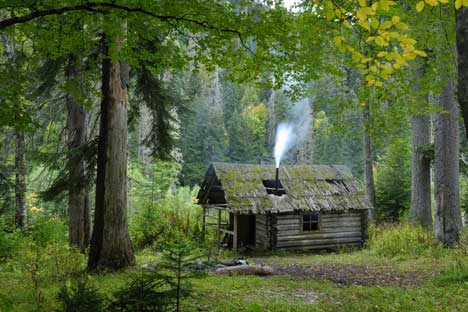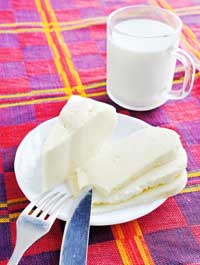
House in woods: a traditional Izba in Adygea. Source: Lori / Legion Media.
While the Caucasus region is mostly known outside Russia as a place of conflict, it has much to offer hikers, backpackers and other adventurous tourists. Hikers in Adygea’s mountains can experience a range of vegetation zones; glaciers, jagged peaks and scree fields loom above overgrown subalpine meadows featuring dozens of flower species, dense Caucasian fir and chestnut forests; on the other side of the mountains is the subtropical climate of the Black Sea.
Located in the south of Russia, the small mountainrepublic of Adygea is a bucolic paradise of tranquil mountains and rivers. Few outsiders come to live here – but not many migrate away from their native land, either.
Famed for its slow pace of life, the region has been in the news of late, with the River Belaya responsible for more column inches more than the Olympics and Pussy Riot. The reason? Its pristine waters, which are usually clear as a tear, has been in the headlines have been infiltrated by mud, which has caused the local trout population to disappear.
Hiking, biking and a giant furry mountain creature
Maykop, the capital city, has 167,000 residents. The remaining 283,000 live in district centres and villages scattered across mountain ridges, divided into some 80 different ethnic groups. The indigenous people – the Adyghe – live in isolated villages on the northern plains, while the mountain regions are populated by a mixture of nationalities – Russians, Circassians, Greeks, Roma, Armenians and Kurds – all with a variety of faiths and traditions. “We have no conflicts – they are left for the towns,” says my guide Sergey, a horse-keeper, looking at the mountains around us. “People live in separate farmsteads here and no one cares about your gods.
“There is the village of Temnolesskaya near the plateau: Old Believers live there. They wear long skirts to the ground and a kerchief on their heads. They placed a cross on the mount. It protects the entire valley – Christians and Muslims.”
Indeed, the religions have merged into one special Adyghe variety, with Muslim Qurban and Old Believers’ crosses standing on rocky slopes among Baptist churches which prop up steep cliff walls. Khodzha, a rich Circassian from Guzeripl, has built a mosque, synagogue and Orthodox church near his house. Their lights wink at him at night, to the tune of cicada songs.
I walk with Sergey and his horse uphill, along a meadow strangely named “Lob Lenina” (Lenin’s Forehead), cutting through fields of varied grasses as his horse snaps at violet burdock flowers the size of tennis balls. Six thousand feet above sea level, the sky is beautifully clear to watch the stars. Telescopes in cases are stacked on the lawn, waiting for their night watch, and Maykop astronomers in their tents are mapping out the Milky Way.
Tourist adventures

Cheese is the national food of the Adygeis, who live in the
southern foothills of the North Caucuses. Legend has it that a piece of cheese
helped the mythological hero Kuitsyka
defeat a one-eyed giant. When he saw his adversary, the hero squeezed
the cheese in his hand until the whey dripped to the ground. Mistaking the
cheese for a piece of rock, the giant fled, thinking Kuitsyka had great
strength. Adygei cheese has a subtle aroma of flowers. The
traditional cheese recipe is simple: sieved cow’s milk is heated over a fire,
and, when it starts boiling, sour-milk whey added when boiling. The curd is
boiled for five minutes and then half of the whey is removed. The warm
cheesemass is then placed in special special baskets made of thin willow-twig
baskets – which produce the typical pattern on the edges.
In the late Nineties, people started setting up small companies to offer mountain activities, such as hiking and abseiling, and family-run guesthouses emerged at the same time. Sergey Shubin, head of the tourism department of the Maykop district administration, says thatit’s the locals who suggest new developments for the area: “They know the best paths, where the villages are, the names of the ridges and dangerous places. Making new tracks and ensuring safety is an impossible task for private entrepreneurs, mostly for financial reasons. The local authorities must provide the infrastructure.”
Ruslan graduated from the mathematics faculty at Maykop University. Unable to find a job as a mathematician, he set up one of the first travel agencies in Khadzhokh (which is also known as Kamennomostsky) – the tourist centre of the area. The firm currently employs seven instructors, including Ruslan’s 14-year-old sister Suzanna; Ruslan’s mother cooks for the tourists and his father takes them to the mountains in his good old GAZ-66 – an invincible truck that is often used in Russia to carry military personnel and was used in Soviet times to transport potatoes.
“It was hard when we were making the first steps”, Ruslan says. “We didn’t know the rules. We didn’t know how to develop the routes and provide safety. But we saw the demand, so we made an offer.” He became one of the first local people to learn the ropes of canyoning, which involves travelling along mountain rivers and through canyons using a variety of techniques.
Archaeological treasures
Adygea is riddled with rivers, brooks and springs. During the Mesozoic era, Adygea was at the bottom of the prehistoric Tethys Ocean, which separated the continents of Gondwana and Laurasia. But the lithospher e ictectonic plates were moving and the ocean ran dry. Consequently, Adygea is rich in sea fossils and ancient shells.
Archaeology students come here all year round to study the dolmens – ancient pyramid structures believed to be prototypes for the Egyptian pyramids. The Khadzhokh 1 dolmen is at the edge of an orchard, on a tiny hill encircled by mysterious trees. Despite heavy rain starting to pour,, archaeologist and chairman of the Russian Geographical Society Igor Ogai walks us around this stone structure, amid lightning and gusts of wind, explaining how it is used for everything from a burial place to a prayer house and a road sign.
Mr Ogai alsogives a tour of a private display consisting of everything the archaeologists have discovered and restored in the Maykop region. Its treasures include a helmet belonging to a 17th-century Circassian warrior, dating from the 17th century, spears, bastshoes, hair ornaments, bone charms, precious stones and fossils.
“People come from around the world to see our dolmens – Americans, Frenchmen, Italians, Germans,” he says.
“Our 5,000-year-old monuments are in perfect condition. We want to have a megalithic park here someday soon, to have a single route for all our monuments; and to provide the infrastructure to have for more visitors and more money for further excavations and support for the existing dolmens. “We take care of them with our own money, but we are terribly short of it,” he adds.
All rights reserved by Rossiyskaya Gazeta.
Subscribe
to our newsletter!
Get the week's best stories straight to your inbox